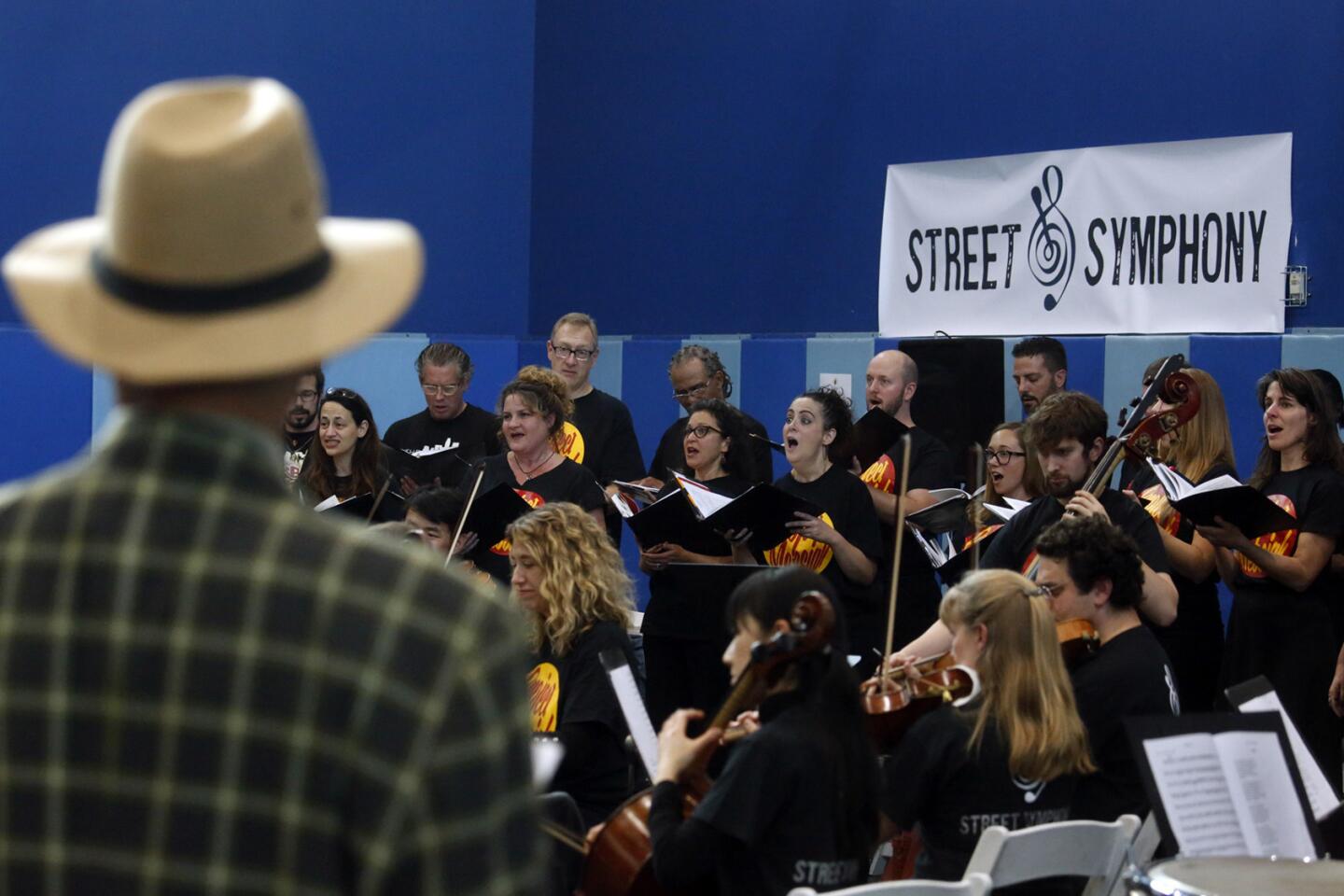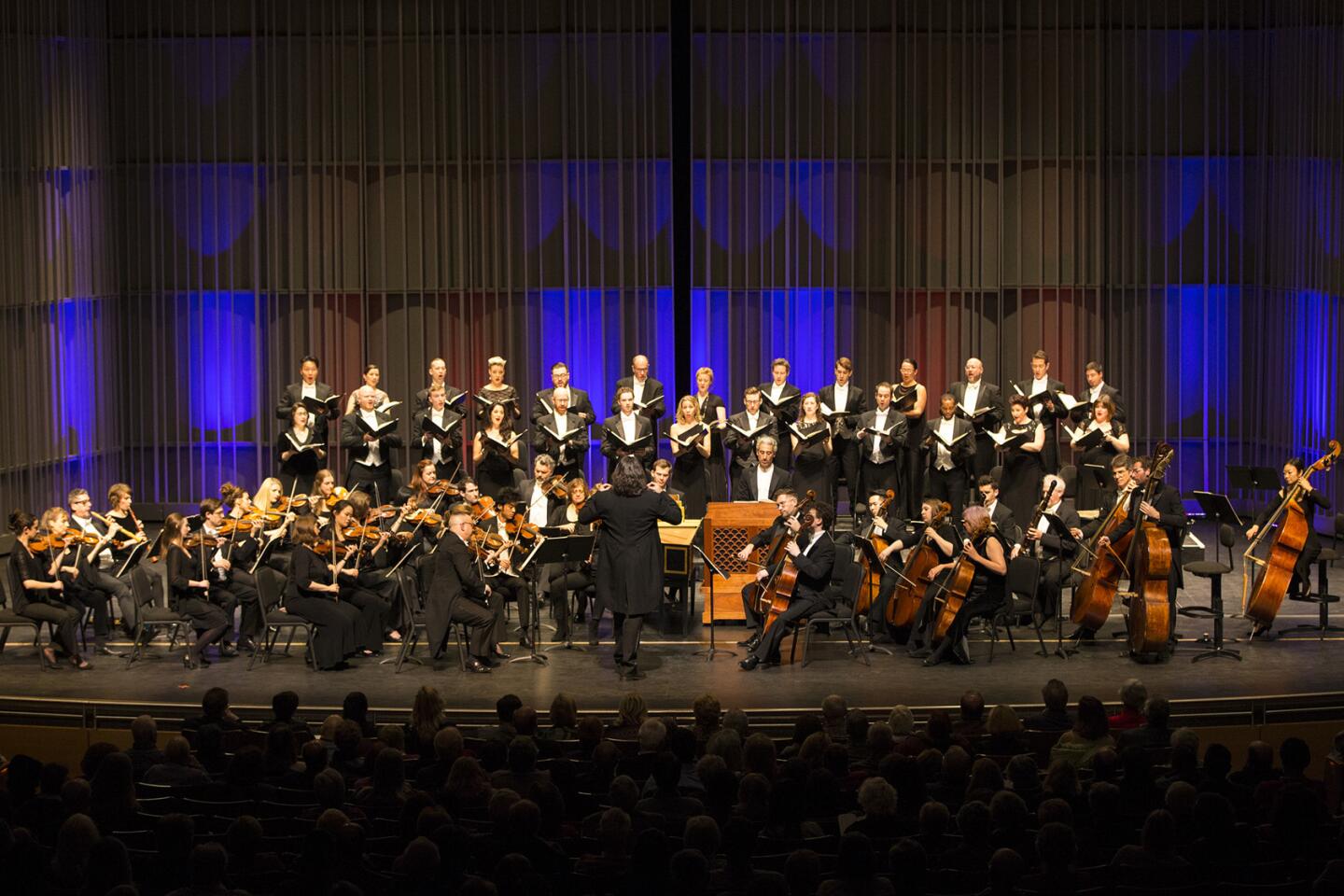Review: ‘The Messiah’ from opposite ends of the economic spectrum

- Share via
Handel’s “Messiah” — by far the finest and most sophisticated of any Christmas staple, whether carol, ballet, poem, painting, cartoon or Jimmy Stewart movie — has always been a people’s musical messiah. The oratorio arrived on the scene to help the needy. Its 1742 premiere in Dublin was a benefit concert for the infirm and the incarcerated in debtors prison.
Today, however, you can have your own “Messiah” however you want it: as a fancy concert experience, a spiritual sacred occasion in church or homey sing-along. Should you have trouble finding exactly what you are looking for in a “Messiah” this time of year, unlikely as that may be, you can find recordings galore.
Last week there happened to be something remarkable: two different (and they couldn’t have been more different) performances of Handel’s oratorio oriented around the one percent — the top and bottom one percent, that is. On Wednesday, Trinity Church Wall Street — built a half-century before the “Messiah” was written and now encircled by hedge funds and a few paces from the New York Stock Exchange — brought its noted Trinity Baroque Orchestra and Choir to the Valley Performing Arts Center in Northridge for a historical Handel.
Two days later on skid row in downtown Los Angeles, Street Symphony — an ensemble made up mostly of members of the Los Angeles Philharmonic and Colburn students performing outreach at jails, homeless shelters and mental-health institutions — offered its second-annual “Messiah Project” at Midnight Mission.
You shouldn’t be surprised to learn which “Messiah” mattered more, which souls are easier to save. The Midnight Mission event included Street Symphony Chamber Singers, core of members from the Los Angeles Master Chorale along with amateurs, as well as Urban Voices Project, whose members are part of the skid row community.
Only a few excerpts of “Messiah” were given. Tenor Don Garza, a Desert Storm combat veteran who is a longtime skid-row resident, made every word in “Comfort ye” intense. When he got to “that her iniquity is pardoned,” his conviction was such that there were shouts of affirmation from the audience and members of the chorus had to put down their scores to dab their eyes.
That alone made this not only the most relevant “Messiah” in my experience but also the most historically authentic. At the Dublin premiere, a reverend, moved to tears by one of the singers, declaimed for all to hear: “Woman, for this, be all thy sins forgiven.”

T-shirts and tuxedoes contrast “The Messiah” performances by Street Symphony.
The “Hallelujah” Chorus, played and sung by superb musicians and filled out with the richest assortment of beautiful and broken voices in the audience, soared with unimaginable power.
I am always reminded upon hearing the “Hallelujah” chorus of a time when, after railing against it, John Cage was approached by an offended woman who asked, “Mr. Cage, don’t you like to be moved?”
“Yes,” Cage answered, “I just don’t like to be pushed.”
There was no pushing Friday at Midnight Mission, none whatsoever, just a need to connect, a need to make “Messiah” something to hold on to. Zanaida Robles, an educator who also works in film and television, conducted with a sense of mission.
Street Symphony’s founder, L.A. Phil violinist Vijay Gupta, told the crowd that “the musicians were walking away with a far greater gift than we can ever hope to give back to the community.” Musician after musician thanked the skid-row community for being their more most rewarding audience. However suspiciously this might sound like TED talk, the fact is that even a “Messiah-ed”-out visitor could hear every note anew.
There were no huddled masses of homeless to maneuver through to get to Valley Performing Arts Center, and there was obviously no way Trinity could come close to creating the indescribably valuable sense of occasion that Street Symphony did. And to be fair to Trinity, which clearly has the resources to support an active music program that is widely hailed by the New York press, the church has an admirable and extensive outreach program. Moreover, VPAC goes out of its way to serve Cal State Northridge and the Valley with reasonably priced tickets.
If this uncaring ‘Messiah’ is evidence, the church’s resources are probably better spent on the community than on music.”
— Mark Swed
Still, if this uncaring “Messiah” is evidence, the church’s resources are probably better spent on the community than on music. Julian Wachner conducted ostentatiously, micromanaging details but with little sense of actual drama. A dozen members of the chorus also served as soloists, somberly stepped forward as though auditioning, singing with studied formality, with the exception of a natural warmth from soprano Molly Netter.
It was, however, a happy touch that the light-tone bass, Edmund Milly, understood his role as a Wall Street chorus member was to make sure that his “For this corruptible must put on incorruption,” was pronounced with perfect diction and indignation.
The orchestra, said to be the best period-instrument group in New York, is made up of fine professionals who played like callous freelancers on a job. Appearances matter. Dressed overly formally in white tie and tails, nearly all wore casual shoes, as though the whole thing was, and is, a sham. An oboe player, when not playing, sat kicking a crossed leg, his striped socks and lime-green water bottle the main visual attraction on stage. It was “Mozart in the Jungle” in the flesh.
Dress at Midnight Mission was, of course, varied, sometimes surprisingly so, with some members of skid row finely decked out. There weren’t just bits of the “Messiah” but also an engaging new piece by the young Street Symphony composer-in-residence, Reena Esmail, “Take What You Need,” that sounded like Sondheim at his most lyric and without the cynicism. The engagement included places for the strings to vamp while three members of the Urban Voices came forward to tell their stories.
Another moving addition was two verses from the late Leonard Cohen’s “Hallelujah” as sing-along following Handel’s. This could become a new tradition.
In the coming days, many of the “Messiah Project” players and singers will be participating in L.A. Phil’s back-to performances of Handel’s “Messiah” and John Adams’ “El Niño,” a latter-day, Latino-inspired “Messiah” that looks at the life of real people in relation to the concept of Nativity.
Although Walt Disney Concert Hall is but a healthy walk from Midnight Mission, it might as well be as far away for the skid row residents as the Goldman Sachs headquarters near Trinity Church in lower Manhattan. But skid row will surely be felt.
I would love to see a video of Don Garza singing “Comfort ye” shown to set the mood for those performances. But when Street Symphony performers can show it’s a wonderful life lived for music, I think we will be in good hands.
More to Read
The biggest entertainment stories
Get our big stories about Hollywood, film, television, music, arts, culture and more right in your inbox as soon as they publish.
You may occasionally receive promotional content from the Los Angeles Times.


















